All-terrain vehicles improve access to the backcountry. ATVs and side-by-sides excel at carrying people, but their restricted cargo room limits the gear we can haul in, and the meat we can pack out. To better suit my outdoor adventures and projects around my homestead, I needed more space to haul the necessary gear. It was time to build a utility trailer!
Advertisement
In the spirit of any good DIY project, salvaged materials kept my costs down. I used as much repurposed metal as possible to create my ATV trailer. When using old metal, good prep improves weld quality, so I brushed or ground off rust and old paint.
Advertisement
I rate this project as intermediate both for its required skill level and time to complete. To tackle this project, you’ll need access to a welder and a compliment of workshop tools. I chose wood planks for the decking, so a method to cut wood to length helps too. I’m not a welder by training, so there was a steep learning curve.
Nevertheless, using a MIG welder and attention to detail, I achieved ‘professional’ results.
The hardest part of the project was coming up with a design. Plan considerations included trailer purpose, bed size, ground clearance, tires, hitch, load capacity and overall trailer weight. Some of decisions were easy, based on locally available materials – type of hitch, for example. Others crystalized after much deliberation. With my trailer specs and materials in hand, it was time to start cutting.
Advertisement
I cut the metal parts with a chop saw, a bandsaw and a special thin cutting blade on an angle grinder – any of the three will work well. The three-foot by five-foot frame was built using one-and-a-half-inch square tubing, which is strong and makes a superb platform on which to mount everything else. Simple butt joints to make neat square corners simplified welding for a beginner. Using two-inch square tubing for extra strength, I welded the tongue at 26 inches, allowing ample clearance between the ATV and trailer, even during tight turns. For frame strength and a place to secure the decking, I welded angle iron side to side across the trailer in strategic locations.
For frame strength and a place to secure the decking, I welded angle iron side to side across the trailer in strategic locations.
The wheel assembly is the most complicated part of this project. An online search returns several suitable ideas, from a simple straight axle with no suspension, to more complex walking axle designs. For me, design considerations included the type of tire. I opted for a standard 14-inch trailer tire and reduced the fabrication process by purchasing a pair of bolt-on equalizer torsion axles for a five-bolt rim. Swapping tire hubs to a four-bolt ATV style will accommodate off-road ATV-style floatation tires. I fabricated the axle supports using angle iron. Using the wheel assembly as a template, I marked and drilled holes to accommodate the bolts.
I used a wire wheel on an angle grinder to clean and rough up the metal surface of the trailer prior to painting. For paint, a rattle-can of spray paint for metal did the trick. To prevent slipping when wet, I plan to add a rubberized rocker guard paint on the tongue.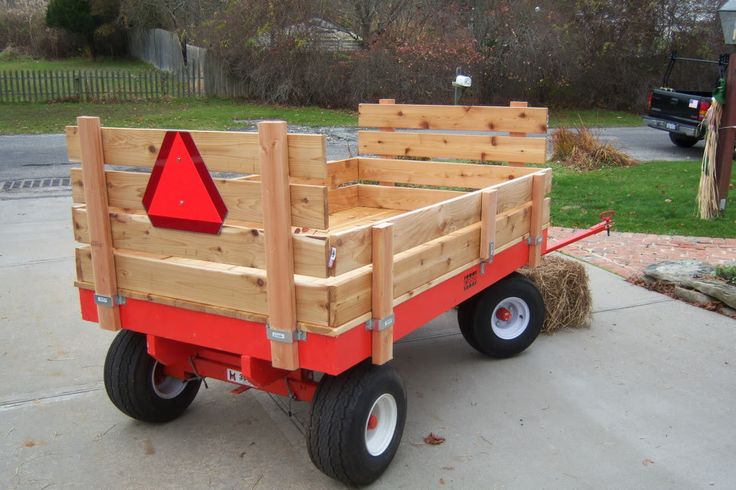
With the trailer still upside down, I bolted the axle assemblies to the frame and installed the tires. My wife and I easily lifted the trailer off the sawhorses and rotated it to sit on the ground right-side up. It wasn’t too heavy, yet!
Next was cutting the trailer decking – I used spruce 2x6s and 2x8s – securing them to the trailer using self-tapping metal screws into the angle iron supports. For longer life, I’ll paint the deck with a water seal. Treated lumber works well too, I just didn’t have any on hand at the time.
After the trailer frame and deck was built, it was time to focus on the sides. For now, I just needed a cart to haul logs and game out of the field, so I added arms that flare out from the trailer for more capacity. An alternative is quick-detach brackets and modular sides to slide in, to suit your adventure.
The last step was installing a trailer coupler. I used a standard part-store aluminum ball-hitch coupler, simply bolting the basic coupler through the tongue.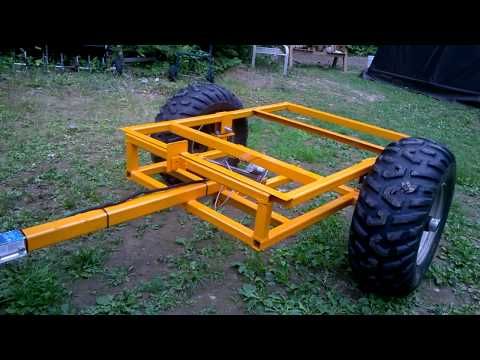 I admit, I do admire the swivel hitch designs for safety considerations in rough terrain – if you misjudge your centre of gravity, your cart can tip without flipping the ATV on its side as well.
I admit, I do admire the swivel hitch designs for safety considerations in rough terrain – if you misjudge your centre of gravity, your cart can tip without flipping the ATV on its side as well.
I had a great deal of fun researching and building this project. I learned new skills and created something that makes me proud to look at and use. Plus, I now have a custom trailer that is more solid and heavy-duty than most commercially made items of this size. If I wished to get it inspected and licenced, I could use it on the road behind my truck as well.
Have fun choosing your options and building your own utility trailer!
Step 1, plans and parts: I decided on the size, shape and parts specification for the trailer I wanted to build. I scrounged used metal where I could and purchased the parts and materials I needed.
Step 2, layout: Metal parts measured and marked in preparation for cutting.
Step 3, cutting: I used a chop saw to cut most of the metal parts to length. A metal cutting bandsaw is another method for cutting metal parts.
A metal cutting bandsaw is another method for cutting metal parts.
Step 4, metal preparation: Good metal preparation is crucial to good welds, especially when using recycled metal. Here, a wire brush on an angle grinder removes old paint and rust.
Step 5, welding: Magnetic clamps hold the workpiece while welding, keeping everything square. For the perfect fit, the axle assemblies were used as a spacer while the supports were tack-welded into place.
Step 6, painting: After welding the frame, the steel was painted before assembling.
Step 7A, assembly: The axel assemblies were bolted onto the frame supports, followed by tire installation.
Step 7B, assembly: The hitch coupler was bolted to the tongue to facilitate future upgrades or replacement.
Step 8, final details: Install side arms and pre-cut decking.
The final product, showing clearance, axel assembly and tires.
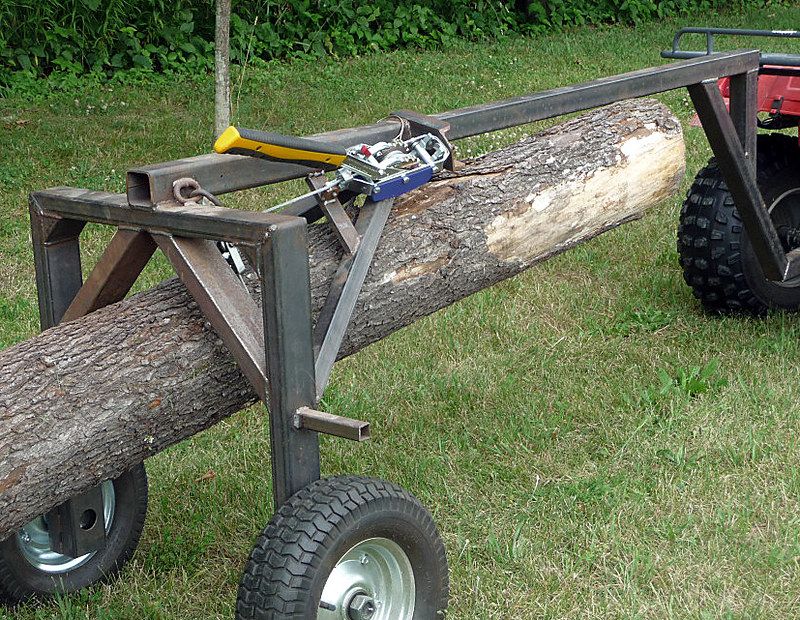
by Don Kress
black atv image by Dumitrescu Ciprian from Fotolia.com
Building a pull-behind trailer for your ATV, whether you are a hunter or simply want to haul heavy loads around your property, makes practical sense. Building your own trailer can save you hundreds of dollars, and you can also set up the trailer as you see fit.
Cut two of the eight foot boards into four foot sections, and then lay them on the ground parallel to each other. The two closest to each another will form the base of the trailer.
Cut the two six-foot boards into three foot sections, and then use screws to build two rectangles from these pieces.
Use the jig saw to cut a piece from the plywood that is three feet wide by four feet long. Screw this piece to the base of the body of the trailer. Then cut the two side boards, each of which will measure one foot wide by four feet long.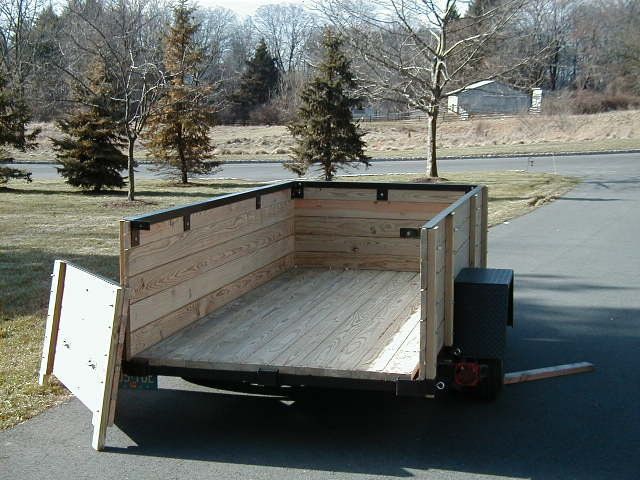 Cut the front and back panels next, measuring one foot wide by three feet long.
Cut the front and back panels next, measuring one foot wide by three feet long.
Cut four one-foot sections from the remaining 2-by-4 board and screw these to the inside corners of the trailer's base. With all four in place, screw the top frame of the trailer to the standing pieces to form a box, and then screw into place the side boards as well as the front and back boards.
Install the tires and wheels to the axle, and then install the axle on the bottom side of the trailer, securing it with carriage bolts. Next, install the tongue of the trailer running from the axle shaft out the front of the trailer. Drill holes where this will be placed, and secure it with carriage bolts in at least three places. Secure the trailer to the ATV hitch with a clevis pin.
References
Tips
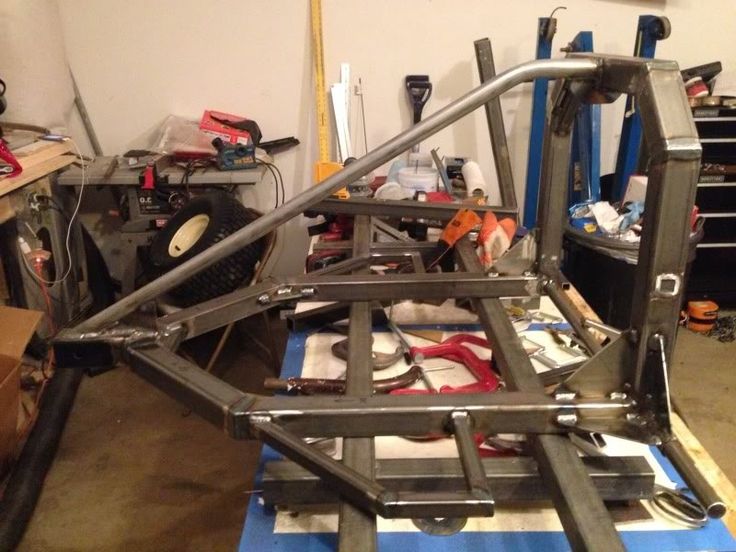
Things You'll Need
Writer Bio
Don Kress began writing professionally in 2006, specializing in automotive technology for various websites. An Automotive Service Excellence (ASE) certified technician since 2003, he has worked as a painter and currently owns his own automotive service business in Georgia. Kress attended the University of Akron, Ohio, earning an associate degree in business management in 2000.
Having a walk-behind tractor or a minitractor in your household, you can significantly expand the garden for planting horticultural crops. However, this technique requires a cart. You can buy it from different shipping companies, but it's cheaper to make your own cart. Many owners, having studied the recommendations and rolled up their sleeves, undertake to make a home-made trailer for a walk-behind tractor
However, this technique requires a cart. You can buy it from different shipping companies, but it's cheaper to make your own cart. Many owners, having studied the recommendations and rolled up their sleeves, undertake to make a home-made trailer for a walk-behind tractor
.
Contents
Making a cart for a walk-behind tractor or a trailer with your own hands does not present any difficulties, if you wish, the necessary tools and experience in such matters. The very device of such mechanisms depends on the purpose and load capacity. Naturally, the heavier it is planned to carry the load, the more difficult the trailer will be. The principal drawing shows the main nodes.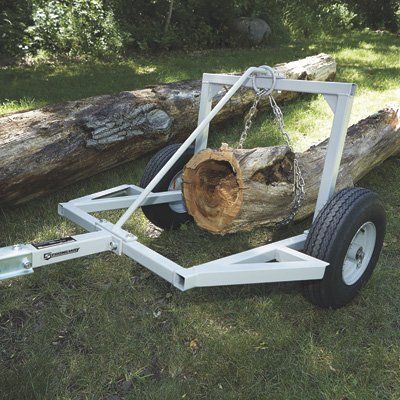 nine0003
nine0003
For light and medium categories of walk-behind tractors, single-axle trailers are made with a body size of approximately 140 × 100 cm. This is the simplest design, the load capacity of which is up to 350 kg. For quick assembly, the body is often made rigid - without shock absorbers.
Those who made a walk-behind tractor with their own hands from the rear axle of a VAZ know very well that wheels for such a cart can be taken not only from Zhiguli. For these purposes, 9 will do.0021 bridge from Moskvich .
It is already with springs, eyelets and earrings. All that remains is to weld the main frame from a professional pipe, which is fixed to springs . Then weld the racks for the sides, build a carrier and install a tow hitch. As a result, the body of the cart is ready.
It is manufactured in the same way as a solid body trolley. Only in this case, three sides are made folding for ease of unloading bulk materials . It will fit large-sized cargo weighing up to 400 - 500 kg. All sides are hinged. In the raised state, they are fastened with special latches. The body is sprung and connected to the axle by means of springs and other elastic suspension elements.
This is the most popular type of trolley. They are made in both small and large sizes. In a simple design, they are sometimes not sprung. Boards are made folding . For people who made wheels for a walk-behind tractor with their own hands, it is not a problem to make the same ones for a trailer. They are taken from the old unusable Zhiguli along with the hubs. The body itself is attached by the middle part directly to the frame through pipe sections or on hinges as shown in the photo. nine0003
nine0003
This cart is very convenient to use for a walk-behind tractor or a walk-behind cultivator. It is easy to operate. The seat is located at the level with the sides, which gives a circular view of the entire unit.
In the transport position, the body rests on a special latch, which can be manual or foot, and it is located next to the driver. The fastening of the body to the frame is made of pipe sections, and the center is located so that when the latch is removed, the platform will tip over on its own. The tailgate is made folding or on open loops. Remove it if necessary. nine0003
Often, if you have ready-made wheels from a car, the question arises: how to fix them on the frame of a future cart or how to make an axle for a trailer with your own hands. There are two outputs here:
 This is a simple option, but the huge gearbox housing spoils the look of the cart;
This is a simple option, but the huge gearbox housing spoils the look of the cart; If the trailer is to be used on a vehicle, it is necessary to purchase a factory hitch that meets all quality and reliability standards.
When used on a walk-behind tractor, you will have to make it yourself and fit it to the hitch.
There are alternative types of carts for walk-behind tractors.
This is a heavy type of trailers, they are made biaxial. They are suitable only for large categories of walk-behind tractors or cars.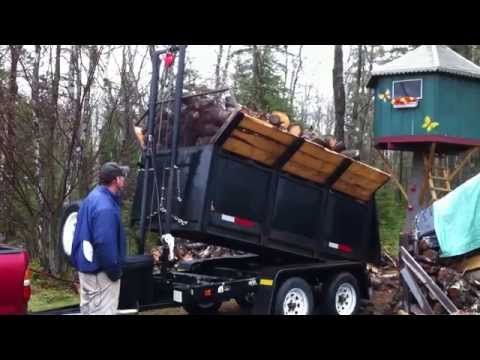 They are mainly used in apiaries when transporting bees, as well as for transporting boats to water bodies. nine0003
They are mainly used in apiaries when transporting bees, as well as for transporting boats to water bodies. nine0003
They are an ordinary platform on wheels, the axles of which are located in the middle part next to each other. Bortovne have, but there is a soft spring suspension, which evenly distributes the load on all four wheels.
The size of the body depends on the purpose and is from 3.5 meters or more in length and from 1.7 to 2.2 meters in width. With the improvement of such carts, a real trailer is easily obtained, which will be a great place for rest and lodging for the night for lovers of long journeys. nine0003
To do this, it is necessary to put and strengthen a light and insulated plastic or wooden frame with windows and a door on the platform. Inside you can place everything you need for a comfortable pastime.
You should be responsible for the manufacture of a drawbar for coupling with your car. It is also necessary to provide hooks for a safety cable or chain, as well as equip it with all the necessary alarms.
This trolley consists of two wheels and a hitch. The frame is shortened, since the body is not provided here. The length of the carrier is chosen so that it is convenient to drive the transport. Install wheels of the same size.
As a result, you can get a good front-wheel drive homemade ATV.
For such purposes, the Neva walk-behind tractor is most suitable, which has 4 forward and 2 reverse speeds and a mass of about 90 kg. Engine power 6.5 - 7 liters. with., which is quite enough for off-road operation. The size of the wheels is sometimes increased both in diameter and in width. nine0003
To increase the functionality, the walk-behind tractor is converted into a minitractor. In this case, the rear wheels become driving. Ground grip is increased by adding rider weight. Then it is quite possible to use a moldboard plow together with a harrow for cultivating the land.
Having built a homemade ATV, you need to take care of a trailer for it.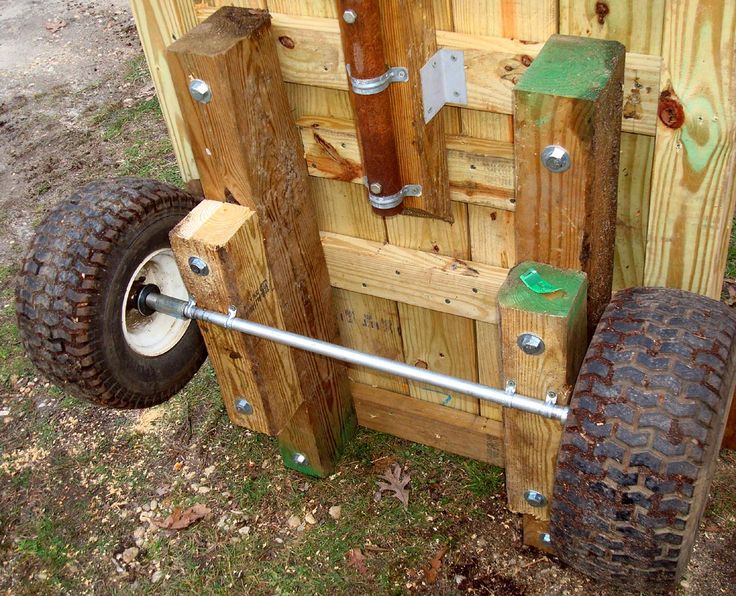 Then this unit will be used at 100%. He will be able not only to plow and sow, but also to transport heavy loads over decent distances. A single-axle light-duty dump trailer is best suited. nine0003
Then this unit will be used at 100%. He will be able not only to plow and sow, but also to transport heavy loads over decent distances. A single-axle light-duty dump trailer is best suited. nine0003
Buying an ATV for a child or an adult means getting a device that is highly reliable, has excellent cross-country ability, and is unpretentious to operating conditions. A trailer will help to significantly expand the functionality of this type of motorized equipment, which can either be purchased at a specialized store or made by hand. Many models of ATVs are capable of transporting even loads weighing a ton, and therefore a homemade trailer will be extremely useful in the household. nine0003
An ATV trailer is an auxiliary vehicle that is not equipped with an engine, and therefore can only be moved together with a motorbike. To connect motorcycles to a trailer, special fastening devices are used, for example, a hook-and-loop.
Please note that there are significant differences in driving an ATV with and without a trailer, namely: nine0012
When it comes to trailer maintenance, special attention must be paid to the coupling point. It is this that is subject to the most wear and tear.
The desire to build a home-made trailer for an ATV usually arises from a motorist for the following reasons:

On the net you can find ready-made diagrams, drawings and manuals on how to make a trailer for an ATV with your own hands. Therefore, you have the right to choose absolutely any option in accordance with your own preferences and budget. Do not forget to take all the necessary measurements from the ATV, if they are not indicated in the motorbike passport. nine0003
The assembly of such a transport structure consists of the following steps:
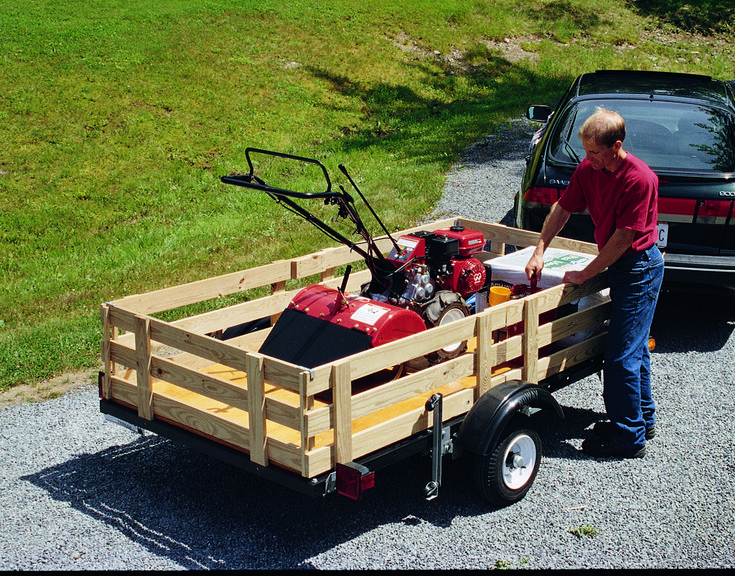 The length of the ATV trailer platform directly depends on the dimensions of your motorcycle model;
The length of the ATV trailer platform directly depends on the dimensions of your motorcycle model; In order for the trailer to be easy to use and not greatly reduce the maneuverability of the vehicle, their dimensions must match. Before starting work, thoroughly consider the design of the structure. At the final stage of creating an ATV trailer with your own hands, be sure to cover the surface of the product with an anti-corrosion coating, due to this it will be possible to significantly extend its service life. nine0003
Trailer wheels can be chosen by the owner at his own discretion, unless it is necessary to make sure that they fit the type of axle being used. Often, heavy automobile wheels with a small surface diameter are used for this purpose. Otherwise, the trailer will turn out to be too bulky.
In the process of making your own ATV trailer, you will also need the following tools:
